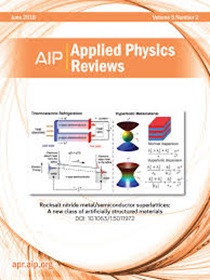Bond dipole-based geometric theory of band alignment
IF 11.9
1区 物理与天体物理
Q1 PHYSICS, APPLIED
引用次数: 0
Abstract
The band alignment (BA) between two materials is a fundamental property that governs the functionality and performance of electronic and electrochemical devices. However, despite decades of study, the inability to separate surface properties from those of the bulk has made a deep understanding of the physics of BAs elusive. Building on the theory of the ideal vacuum level to separate surface from bulk [Choe et al., Phys. Rev. B 103, 235202 (2021)], here we present a geometric theory for the band alignment, specifically explaining the insensitivity of the alignment to interfacial orientation between isotropic materials. First, we adopt a neutral polyhedron, termed Wigner-Seitz atoms (WSA), to partition the charge of atoms in a way that maintains crystal symmetry and tessellates the space. In contrast to the CWZ theory, the band alignment of two materials constructed from such WSAs is independent of interface orientation. Upon electron relaxation at the interface, we show that the interfacial charge transfer dipole can be accurately described by the sum of localized point dipoles that exist between atoms at the interface (bond dipoles). For interfaces between isotropic materials, the magnitude of the bond dipole can be factored out as a multiplier, leaving only geometric factors, such as crystal symmetry and dimension of the material, to determine band alignment, regardless of the orientation of the interface. We considered 29 distinct interfaces and found that this bond dipole theory yields excellent agreement (RMS deviation < 30 meV) with first-principles results. Our theory can be easily applied to interface between alloys, as well as between anisotropic systems.基于键偶极子的能带对准几何理论
两种材料之间的能带对准(BA)是控制电子和电化学器件功能和性能的基本特性。然而,尽管经过了几十年的研究,由于无法将表面性质与体的性质分开,使得对ba的物理性质的深刻理解变得难以捉摸。在理想真空水平理论的基础上,分离表面和体[Choe等人,物理学。Rev. B 103, 235202(2021)],本文提出了波段对准的几何理论,具体解释了各向同性材料之间的界面取向对波段对准的不敏感性。首先,我们采用一个中性多面体,称为Wigner-Seitz原子(WSA),以一种保持晶体对称性和镶嵌空间的方式划分原子的电荷。与CWZ理论相反,由这类wsa构建的两种材料的能带排列与界面取向无关。根据电子在界面上的弛豫,我们证明了界面电荷转移偶极子可以用存在于界面原子之间的局域点偶极子(键偶极子)的总和来精确描述。对于各向同性材料之间的界面,键偶极子的大小可以作为乘数分解,只留下几何因素,如晶体对称性和材料的尺寸,来决定带的排列,而不管界面的方向如何。我们考虑了29种不同的界面,发现这种键偶极子理论产生了极好的一致性(均方根偏差&;lt;30mev),得到第一性原理结果。我们的理论可以很容易地应用于合金之间以及各向异性系统之间的界面。
本文章由计算机程序翻译,如有差异,请以英文原文为准。
求助全文
约1分钟内获得全文
求助全文
来源期刊

Applied physics reviews
PHYSICS, APPLIED-
CiteScore
22.50
自引率
2.00%
发文量
113
审稿时长
2 months
期刊介绍:
Applied Physics Reviews (APR) is a journal featuring articles on critical topics in experimental or theoretical research in applied physics and applications of physics to other scientific and engineering branches. The publication includes two main types of articles:
Original Research: These articles report on high-quality, novel research studies that are of significant interest to the applied physics community.
Reviews: Review articles in APR can either be authoritative and comprehensive assessments of established areas of applied physics or short, timely reviews of recent advances in established fields or emerging areas of applied physics.
 求助内容:
求助内容: 应助结果提醒方式:
应助结果提醒方式:


